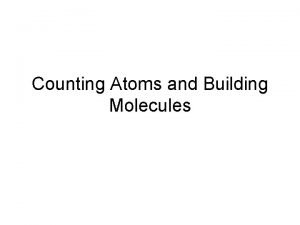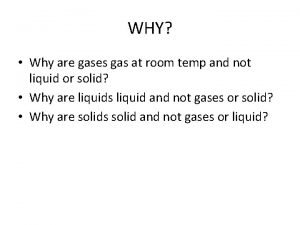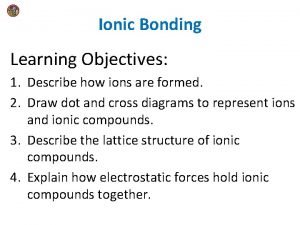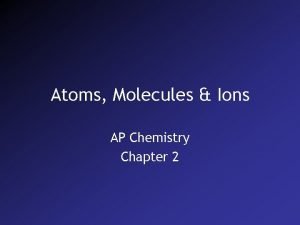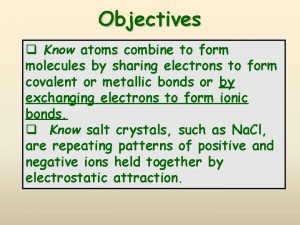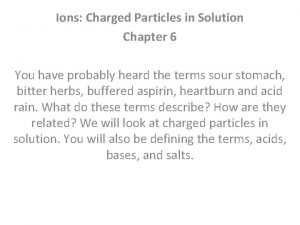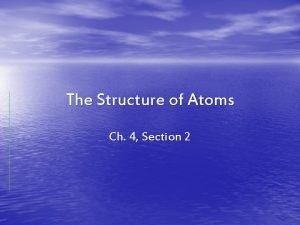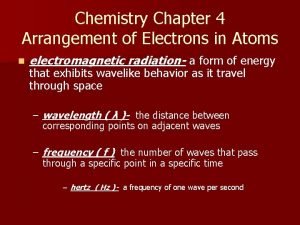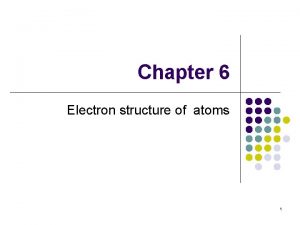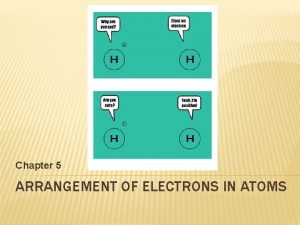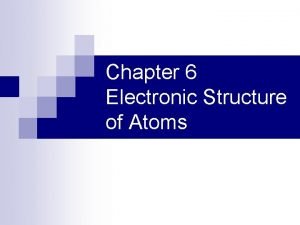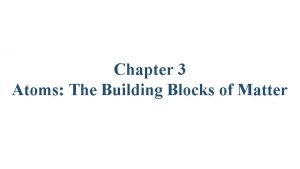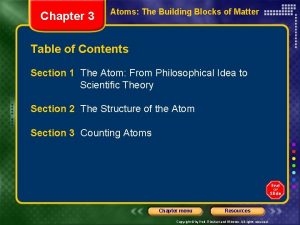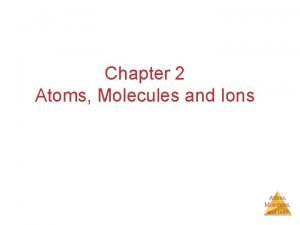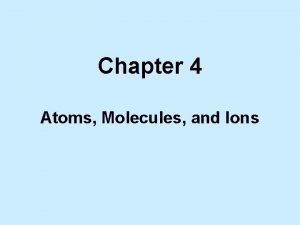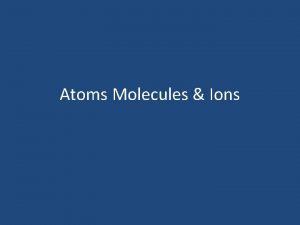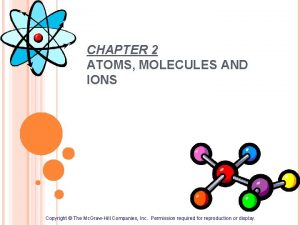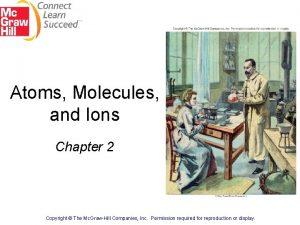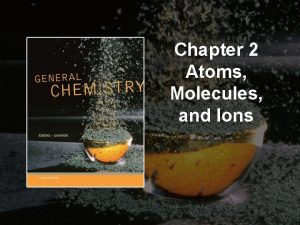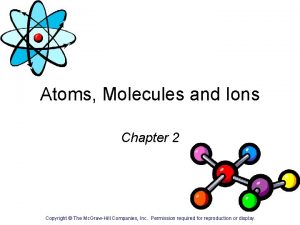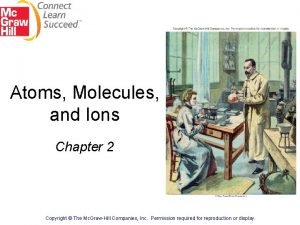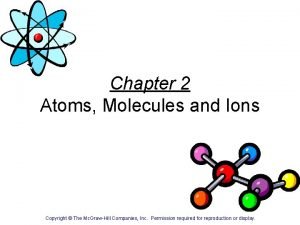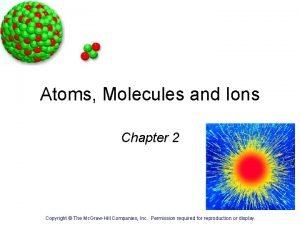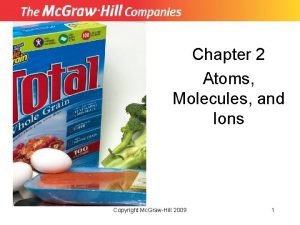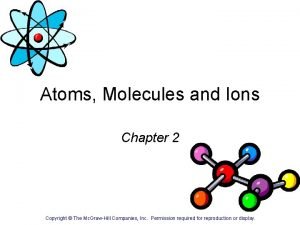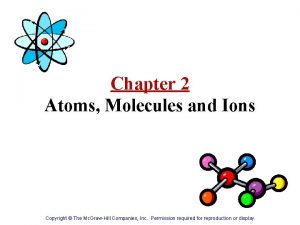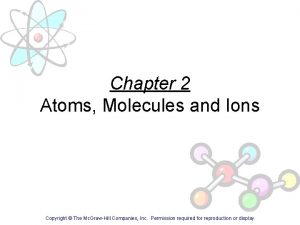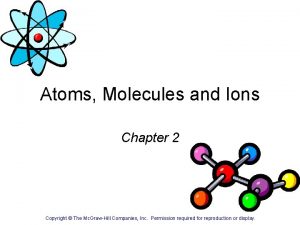Atoms Molecules and Ions Chapter 2 Copyright The





















































- Slides: 53

Atoms, Molecules and Ions Chapter 2 Copyright © The Mc. Graw-Hill Companies, Inc. Permission required for reproduction or display.

Democritus was a Greek philosopher who lived between 470 -380 B. C. He developed the concept of the 'atom', Greek for 'indivisible'. Democritus believed that everything in the universe was made up of atoms, which were microscopic and indestructible. Democritus had many remarkable insights for his time. He understood that the Milky Way was a large collection of stars and also thought that space was limitless. His insights were not supported by scientific evidence until the 18 th century.

Aristotle rejected the idea of atoms. He did not believe that empty space could exist. Because of his views, Democritus’ ideas were not accepted until many centuries later. Aristotle believed that empty space did not exist and that matter is made of earth, fire, air and water, not atoms.

John Dalton (1766 -1844) formulated his atomic theory to explain chemical reactions, based on the concept that the atoms of different elements are distinguished by differences in their weights. Dalton’s Atomic Theory (1808): The basic components of matter are atoms, and only whole numbers of atoms can combine to form compounds. He first described color blindness, and he kept a meteorological journal with over 200, 000 observations during his lifetime.

Dalton’s Atomic Theory (1808) 1. Elements are composed of extremely small particles called atoms. Atoms are indivisible. 2. All atoms of a given element are identical, having the same size, mass and chemical properties. The atoms of one element are different from the atoms of all other elements. 3. Compounds are composed of atoms of more than one element. In any compound, the ratio of the numbers of atoms of any two of the elements present is either an integer or a simple fraction. (Laws of D. P. and M. P. ) 4. A chemical reaction involves only the separation, combination, or rearrangement of atoms; it does not result in their creation or destruction. (Law of C. of M. ) 2. 1

Theory: An explanation supported by many experiments; is still subject to new experimental data, can be modified, and is considered successful if it can be used to make predictions that are true.

The Law of Multiple Proportions The atoms of different elements combine in simple whole number ratios to form compounds

Dalton’s Atomic Theory 2 2. 1

Antoine Lavoiser • Frequently referred to as the “Father of Modern Chemistry” • Stated the first version of the Law of Conservation of Mass 1743 -1794 • Credited with the discovery of the elements oxygen and hydrogen • Reformed chemical nomenclature • Executed during the French Revolution

The Law of Conservation of Mass is neither created nor destroyed during ordinary chemical reactions or physical changes

16 X + 8 Y 8 X 2 Y 2. 1

The Law of Definite Proportions The size or source of a sample of a compound has no effect on the proportion of elements in that compound e. g. H 2 O is always H 2 O

ATOM The smallest particle of an element that retains the chemical properties of that element

What is the atom composed of?

Discovering the Electron • Because of Dalton’s atomic theory, most scientists in the 1800 s believed that the atom was like a tiny solid ball that could not be broken up into parts. • In 1897, a British physicist, J. J. Thomson, discovered that this solid-ball model was not accurate. • Thomson’s experiments used a vacuum tube.

Discovering the Electron • A vacuum tube has had all gases pumped out of it. • At each end of the tube is a metal piece called an electrode, which is connected through the glass to a metal terminal outside the tube. • These electrodes become electrically charged when they are connected to a high-voltage electrical source.

Cathode-Ray Tube • When the electrodes are charged, rays travel in the tube from the negative electrode, which is the cathode, to the positive electrode, the anode. • Because these rays originate at the cathode, they are called cathode rays.

Cathode-Ray Tube • Thomson found that the rays bent toward a positively charged and away from a negatively charged plate. • He knew that objects with like charges repel each other, and objects with unlike charges attract each other.

Cathode-Ray Tube • Thomson concluded that cathode rays are made up of invisible, negatively charged particles referred to as electrons. • These electrons had to come from the matter (atoms) of the negative electrode. • For measuring the mass/charge of an electron, J. J. Thomson won the 1906 Nobel Prize in Physics.

Robert Millikan (1868 -1953) won the 1923 Nobel Prize in physics for his work on the elementary electric charge (of an electron) and on the photoelectric effect. The photoelectric effect is the emission of electrons from a metal when light shines on the metal, creating an electric current.

The Electron (cont. ) • In the early 1910 s, Robert Millikan used the oil-drop apparatus shown below to determine the charge of an electron.

Measured mass of e- (1923 Nobel Prize in Physics) e- charge = -1. 60 x 10 -19 C Thomson’s charge/mass of e- = -1. 76 x 108 C/g e- mass = 9. 10 x 10 -28 g 2. 2

J. J. Thomson (1856 -1940) demonstrated that electric currents are composed of negatively charged particles, which were later named electrons. He won the 1906 Nobel prize for this discovery, and subsequently discovered isotopes. Atoms were known to be neutral (no charge), but contained positive charges to counterbalance the negative charges. The “Plum Pudding” model of the atom allowed for the charges to spread out as far as possible.

2. 2

Ernest Rutherford (1871 -1937), won the 1908 Nobel prize for his investigations into the disintegration of the elements, and the chemistry of radioactive substances. • Aim was to support the “Plum Pudding” model of the atom • Bombarded a thin gold foil with fast moving alpha particles (positively charged Helium ions) • Discovered the atomic nucleus

(1908 Nobel Prize in Chemistry) a particle velocity ~ 1. 4 x 107 m/s (~5% speed of light) 1. atoms’ positive charge is concentrated in the nucleus 2. proton (p) has opposite (+) charge of electron (-) 3. mass of p is 1840 x mass of e- (1. 67 x 10 -24 g) 2. 2

The atom contains a small dense “core” l Most alpha (+) particles went through the gold foil l A small number of alpha particles were deflected by the gold foil l Atoms must contain a “nucleus” that is positively charged l Additional experiments proved that the nucleus contains both protons (+) and neutrons

Rutherford’s Model of the Atom atomic radius ~ 100 pm = 1 x 10 -10 m nuclear radius ~ 5 x 10 -3 pm = 5 x 10 -15 m “If the atom is the Houston Astrodome, then the nucleus is a marble on the 50 -yard line. ” 2. 2

Discovery of the proton Henry Moseley used cathode rays to knock electrons out of their orbits. When an electron jumped back into orbit, it emitted electromagnetic radiation. According to atomic theory, an electron jumping to the innermost orbit of a heavy atom emits X-rays. From the wavelength of the X-rays, Moseley could calculate the charge of the nucleus. He proved that the charge on the nucleus was equal to its atomic number.

Discovery of the neutron James Chadwick bombarded a sheet of Be with α particles, and found that a type of radiation was emitted that “knocked” protons from paraffin. These particles were identified as the elusive neutron. J. Chadwick 1935 Nobel Prize in Physics

Chadwick’s Experiment (1932) H atoms have 1 proton, He atoms have 2 protons Mass He/mass H should = 2 But, the measured mass He/mass H = 4 a + 9 Be 1 n + 12 C + energy neutron (n) is neutral (charge = 0) n mass ~ p mass = 1. 67 x 10 -24 g 2. 2

mass p = mass n = 1840 x mass e 2. 2

Atomic number, Mass number and Isotopes Atomic number (Z) = number of protons in nucleus Mass number (A) = number of protons + number of neutrons = atomic number (Z) + number of neutrons Isotopes are atoms of the same element (X) with different numbers of neutrons in their nuclei Mass Number Atomic Number A ZX Element Symbol 1 1 H 2 1 H (D) 3 1 H (T) 235 92 U 238 92 U 2. 3

Isotopes The Isotopes of an element have different mass numbers because they have different numbers of neutrons, but they all have the same atomic number.

The Isotopes of Hydrogen 2. 3

Calculating Atomic Mass from Isotope Data

Calculating Atomic Mass from Isotope Data • Copper exists as a mixture of 2 isotopes • The lighter isotope (Cu-63), with 29 protons and 34 neutrons makes up 69. 17% of copper atoms • The heavier isotope (Cu-65) with 29 protons and 36 neutrons, constitutes the remaining 30. 83% of copper atoms

Calculating Atomic Mass from Isotope Data • The atomic mass of Cu-63 is 62. 930 amu and the atomic mass of Cu-65 is 64. 928 amu • Use the data above to calculate the average atomic mass of copper

Calculating Atomic Mass from Isotope Data First calculate the contribution of each isotope to the average atomic mass; be sure to convert each percent to a fractional abundance. Mass contribution = mass of isotope X abundance of isotope For Cu-63: Mass contribution = 62. 930 X 0. 6917 = 43. 529 For Cu-65: Mass contribution = 64. 928 X 0. 3083 = 20. 017

Calculating Atomic Mass from Isotope Data The average atomic mass of the element is the sum of the mass contributions of each isotope. Atomic mass of Cu = mass contribution Cu-63 + mass contribution Cu-65 Atomic mass Cu = 43. 529 + 20. 017 = 63. 546

Calculate the average atomic mass of Germanium.

Radioactivity W. Roentgen 1901 Nobel Prize in Physics In 1895 the German physicist Wilhelm Roentgen discovered that invisible rays were emitted when electrons bombarded the surface of certain materials. The emitted rays were discovered because they caused photographic plates to darken. He called these invisible high energy emissions “X”-rays because he didn’t know what they were. First medical X-ray; Mrs. Roentgen’s hand

Not long after Roentgen’s discovery, French physicist Antoine Henri Becquerel was studying minerals that emit light after being exposed to sunlight, a phenomenon called phosphorescence. Building on Roentgen’s work, Becquerel wanted to determine whether phosphorescent minerals also emitted X rays. A. H. Becquerel 1903 Nobel Prize in Physics Image of Becquerel’s photographic plate which has been fogged by exposure to radiation from a uranium salt. The shadow of a metal Maltese Cross placed between the plate and the uranium salt is clearly visible.

Becquerel accidentally discovered that phosphorescent uranium salts, even when not exposed to light, produced spontaneous emissions that darkened photographic plates. Like X rays, the rays from the uranium compound were highly energetic and could not be deflected by a magnet, but they differed from X rays because they arose spontaneously.

As a student of Becquerel, Marie Curie suggested the name radioactivity to describe the spontaneous emission of particles and/or radiation. M. Slodowska-Curie 1903 Nobel Prize in Physics; 1911 Nobel Prize in Chemistry The rays and particles emitted by a radioactive source are called radiation.

(Uranium compound) 2. 2

Types of Radiation The three most common types of radiation are alpha (α), beta (β), and gamma (γ). Type of Radiation Alpha (α) Beta (β) Gamma (γ) Composition Alpha Particles Beta Particles High energy EM radiation Description Helium nuclei Electrons Photons +2 − 1 0 Charge Symbol Relative Penetrating Power γ Blocked by Paper Blocked by Metal Foil Not completely Blocked by Lead or Concrete

Types of Nuclear Reactions Alpha emission (alpha decay)

Types of Nuclear Reactions Beta Emission (beta decay)

Types of Nuclear Reactions Gamma emission (gamma decay) Gamma rays do not have mass, so there is no change in the nuclear composition of an element undergoing gamma decay. 238 92 U* → 238 92 U + 0 0 γ

Do You Understand Isotopes? 14 How many protons, neutrons, and electrons are in 6 C ? 6 protons, 8 (14 - 6) neutrons, 6 electrons 11 How many protons, neutrons, and electrons are in 6 C ? 6 protons, 5 (11 - 6) neutrons, 6 electrons 2. 3

Do You Understand Ions? 27 3+ How many protons and electrons are in ? 13 Al 13 protons, 10 (13 – 3) electrons 78 2 How many protons and electrons are in ? Se 34 34 protons, 36 (34 + 2) electrons 2. 5

What is an allotrope? An allotrope is a variant of a substance consisting of only one type of atom. Common substances with allotropes are carbon, phosphorous, sulfur and oxygen. Example: allotropes of carbon amorphous (coal, soot) graphite (pencil lead) diamond buckminsterfullerene (Bucky balls)
 Chapter 2 atoms molecules and ions
Chapter 2 atoms molecules and ions Ion chapter 11
Ion chapter 11 Atoms molecules and ions
Atoms molecules and ions Atoms molecules and ions
Atoms molecules and ions Atoms molecules and ions
Atoms molecules and ions Atoms ions and molecules
Atoms ions and molecules Atoms ions and molecules
Atoms ions and molecules States that atoms ions and molecules must collide to react
States that atoms ions and molecules must collide to react Carbon trichloride
Carbon trichloride What is the relationship between atoms and elements
What is the relationship between atoms and elements Substance
Substance 3bacl2 counting atoms
3bacl2 counting atoms Interacting molecules or ions
Interacting molecules or ions Organic molecules vs inorganic molecules
Organic molecules vs inorganic molecules How does a positive ion form
How does a positive ion form Atoms or ions are considered isoelectronic if
Atoms or ions are considered isoelectronic if Atoms combine to form
Atoms combine to form Periodic table of elements regents
Periodic table of elements regents Chapter 6 section 1 atoms elements and compounds
Chapter 6 section 1 atoms elements and compounds Chapter 6 section 1 atoms elements and compounds
Chapter 6 section 1 atoms elements and compounds Modern chemistry chapter 13 review answers
Modern chemistry chapter 13 review answers Ions charged particles in solution
Ions charged particles in solution Chapter 3 molecules of life
Chapter 3 molecules of life Chapter 4 section 2 the structure of atoms answer key
Chapter 4 section 2 the structure of atoms answer key Chapter 4 arrangement of electrons in atoms test
Chapter 4 arrangement of electrons in atoms test Ccechs
Ccechs Chapter 6 electronic structure of atoms answers
Chapter 6 electronic structure of atoms answers Chapter 5 arrangement of electrons
Chapter 5 arrangement of electrons Which of the d orbitals most resembles a pz orbital?
Which of the d orbitals most resembles a pz orbital? Chapter 3 atoms the building blocks of matter
Chapter 3 atoms the building blocks of matter Which subatomic particle has the least mass
Which subatomic particle has the least mass Hình ảnh bộ gõ cơ thể búng tay
Hình ảnh bộ gõ cơ thể búng tay Slidetodoc
Slidetodoc Bổ thể
Bổ thể Tỉ lệ cơ thể trẻ em
Tỉ lệ cơ thể trẻ em Chó sói
Chó sói Glasgow thang điểm
Glasgow thang điểm Hát lên người ơi alleluia
Hát lên người ơi alleluia Môn thể thao bắt đầu bằng từ chạy
Môn thể thao bắt đầu bằng từ chạy Thế nào là hệ số cao nhất
Thế nào là hệ số cao nhất Các châu lục và đại dương trên thế giới
Các châu lục và đại dương trên thế giới Công thức tính thế năng
Công thức tính thế năng Trời xanh đây là của chúng ta thể thơ
Trời xanh đây là của chúng ta thể thơ Mật thư tọa độ 5x5
Mật thư tọa độ 5x5 Làm thế nào để 102-1=99
Làm thế nào để 102-1=99 độ dài liên kết
độ dài liên kết Các châu lục và đại dương trên thế giới
Các châu lục và đại dương trên thế giới Thơ thất ngôn tứ tuyệt đường luật
Thơ thất ngôn tứ tuyệt đường luật Quá trình desamine hóa có thể tạo ra
Quá trình desamine hóa có thể tạo ra Một số thể thơ truyền thống
Một số thể thơ truyền thống Cái miệng bé xinh thế chỉ nói điều hay thôi
Cái miệng bé xinh thế chỉ nói điều hay thôi Vẽ hình chiếu vuông góc của vật thể sau
Vẽ hình chiếu vuông góc của vật thể sau Thế nào là sự mỏi cơ
Thế nào là sự mỏi cơ đặc điểm cơ thể của người tối cổ
đặc điểm cơ thể của người tối cổ











